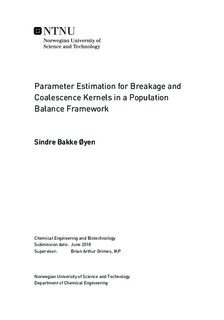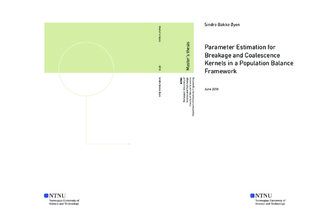| dc.description.abstract | In this work, a zero-dimensional model in the population balance framework has been developed for an oil-in-water emulsion in a batch continuously stirred tank reactor in order to calibrate four parameters to experimental data: two parameters for breakage and two parameters for coalescence. Three different regression approaches were employed: sum of squared errors for the distributions (dSSE), weighted sum of squared errors for the distributions (wdSSE) and sum of squared errors for the statistical mean (mSSE). The non-linear regressions required good initial guesses, and therefore an appropriate parameter space was charted in two directions, keeping the breakage parameters constant. The residual three-dimensional surface for the dSSE had a long, twisting valley with a clear minimum. However, it also had large areas of flat gradients. Given a sufficiently good initial guess, gradient-based optimizers should therefore be applicable to the problem. The same applied for the wdSSE, however, the valley was narrower and shallower. The mSSE had multiple local minima, but the same valley was also observed here.
The previous findings for fixed breakage parameters were promising, and consequently, the parameter search was augmented to four directions, resulting in a disproportional increase in computational complexity. A coarse grid with lower resolution was therefore used for an initial charting. Thereafter, the areas of flat gradients were cut out, and the surfaces were refined with a higher grid point density. The best solutions found for both the coarse and the refined grid were then provided as initial guesses to a Levenberg-Marquardt optimization routine from the GNU Scientific Library. A sensitivity analysis was performed on the optimal parameter combination found for the coarse grid by perturbing the initial guess. It was discovered that the optimal solutions found were also perturbed from the nominal case. The findings were ambiguous and inconclusive. For future work, the internal parameters of the routine should be adjusted in order to ensure desirable convergence properties, and to ensure that the global minimum is found given that a point of descension is provided.
Since measurement devices are expensive, it was also desirable to find a minimum number of measurements required to obtain the same optimal parameter combination. The best solutions found for both the coarse grid and the refined grid were subject to the experiment, and for the dSSE, both initial guesses needed about 30 measurements of the distribution in time for all parameters but one to stabilize. The objective function value per degree of freedom for the wdSSE stabilized at 20 measurements in time for both initial guesses, however, it produced oscillatory behaviors for three parameters for the coarse initial guess and two parameters for the refined initial guess. If the internal parameters of the optimization routine is to be optimized in order to ensure consistent convergence, this experiment should also be repeated to investigate whether the oscillations are connected to the objective function formulation or internally to the optimization routine employed.
Finally, the optimal parameter combination found for all three regression approaches were checked for validity by comparing their dynamical behaviors, their steady state locations and their temporal evolutions of the mean to the experimental measurements. It was found that the dSSE and the wdSSE had very similar behaviors, and since the wdSSE was inferior in every other way discovered, its future use is discouraged. The dynamical behavior of the two was quicker than the experimental observations. At first, the distribution widened, pushing the peak of the distribution down, before it narrowed and pushed the peak up again. The findings contradict the experimental data. Since the model failed to account for the production of the long tail for small droplets, the distribution could not widen at the end to push the peak down again. Therefore the modeled dynamical behavior could not represent the observations properly. The modeled distribution reached steady state somewhat early, but the agreement with the experimental steady state was satisfactory, and both the mode of the distribution and the pronounced gradient at the end due to coalescence were approximately correct. The mSSE, on the other hand, narrowed and kept rising until it reached steady state. For the same reasoning as before, the distribution could not widen again by producing small droplets, and therefore it failed to settle down at the correct peak value. The dynamical behavior was too fast, and the steady state location was unsatisfactory. The tracking of the mean was slightly better for this regression approach, but not good enough to outweigh its discrepancies with respect to the dynamical and steady state behavior. Allover, the dSSE performed better than the other two, making it the best regression approach of the three employed. | |

